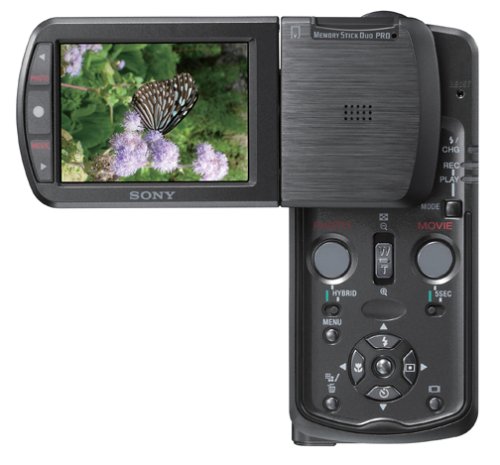Sony Cybershot DSCM1 5MP Digital Camera with 3x Optical Zoom & MPEG4 Video Review


Sony Cybershot DSCM1 5MP Digital Camera with 3x Optical Zoom & MPEG4 Video Feature
- 5.1-megapixel sensor allows for photo-quality prints up to 13 by 17 inches
- Camera features 3x optical zoom in a unique vertical orientation
- Large 2.5-inch free-angle rotating LCD design makes viewing effortless
- Non-extending lens and Real Imaging Processor mean near instant startup and shutter release
- Supplied Cyber-shot Station makes camera-to-TV/PC connection quick and simple
Sony's DSCM1 interestingly designed 5-megapixel digital camera is easy to use right out of the box--and extremely fast, too. The M1 is ready to shoot about as quickly as you can fold out its free-angle LCD, and its unique form factor--the camera looks like a winged robot or a small boomerang--captures subjects' attention immediately.
 |
The M1's Twilight Portrait mode creates interesting effects.
(See larger image.) |
The M1's great features don't end with its fast start-up time, though; the pictures and video this camera takes are amazing. We put it through its paces in a variety of situations, from indoor evening parties to snowy outdoor activities and all sorts of cafes and museums in between, and almost without fail, the results were gorgeous. The camera's Twilight Portrait mode creates great effects by combining a flash with a long exposure time, and the Auto setting could be relied on to deal with even backlit or low-light scenes.
 |
One of the M1's crisp, colorful images from the NYC installation
of Christo's The Gates.
(See larger image.) |
The free-angle LCD, in addition to wowing photo subjects and passersby, is also useful for taking overhead or low-to-the-ground images, or for composing self-portraits. After swinging out the LCD to turn the camera on, the screen can be rotated approximately 270 degrees, making complex shooting situations a snap. In addition, at 2.5 inches, the LCD screen makes viewing images a real pleasure, and we were amazed at how often we found ourselves taking a friend's picture and then showing the friend every image we had stored on the memory card, or pulling out the camera to review images privately during a few minutes of down time.
 |
 |
The M1's interior shots from the new lobby of New York's Museum of Modern Art.
(Click images for larger views.) |
It is also worth noting that the M1's autofocus does an excellent job of quickly evaluating a scene and making relatively intelligent assumptions about the image subject. In the rare cases where edges or features in images were slightly fuzzy, it would've taken a poster-size print for the problem to really stand out. In all cases, the autofocus was quite fast, further contributing to an impressive recycle time between shots.
The areas in which the camera could have done slightly better were in a couple of the scene modes-- Landscape, for example, produced less stunning sunset images than the camera's Auto setting--and in transferring images to a computer. We found that images were less vibrant on the computer than on the M1's screen when transferred to a PC, using either the supplied Picture Package software or treating the camera as an external hard drive. However, it's easy to adjust them slightly using imaging software, and the muddiness did not occur at all when downloading the images to a Mac using iPhoto.
One further drawback is that while the camera body is quite sturdy, the memory card slot is exposed, meaning that taking photographs in inclement weather is an iffy proposition. Also, because the camera comprises three segments joined by hinges, it's got more seams for water and gunk to seep into than would a camera with a simpler construction. (It was not unusual for us to transport the camera in a pocket and pull it out to find that a stray piece of paper had lodged between the LCD and body.) A case would go a long way toward clearing this up, though. --Sarah Sternau
Pros
- It's fast
- Movie mode creates impressive MPEG4 video (with crisp audio) at a length limited only by available memory
- Unique form factor makes complex picture-taking situations easier
Cons- Bulkier than many compact cameras currently available
- Memory card slot is exposed, making wet weather a concern
- Some downloading methods caused the images to lose vibrancy, necessitating simple touch-ups
Sony DSC-M1 Cyber-shot(R) Digital Camera is a remarkably tiny camcorder and digital-camera in one. A key reason is that video and still images are all recorded on MemoryStick or MemoryStick-Pro digital media. It doesn't use any tapes! It's also the first Sony Cyber-shot(R) Digital-Camera to offer MPEG-4 codec for excellent video motion recording and, in a sense, is styled more like a camcorder than a compact digital camera. Cyber-shot(R) DSC-M1 is a 5.1-megapixel digital still camera that pays particular attention to the role moving images play in preserving memories, and even more attention to making it easy to use. The camera, a slim, matte-black device about the size of a deck of cards, is held vertically, and its 2.5-inch articulated LCD swivels upward and rotates a full 270 degrees. This new shooting orientation provides more surface area to access both the menu navigation buttons and two "hot" buttons for direct access to recording stills and video. The outer edge of the LCD also has buttons serving two functions. While the LCD is extended and the camera is in record mode, the buttons can be used to record, and toggle back and forth between stills and video. When the LCD is facing outward, but flush with the camera's body, the buttons can be used to playback stills and video, turning the camera into a personal media viewer. Up to 640x480 VGA movie images Large 2.5 LCD viewer Auto and manual focus modes Programmed and manual exposure modes Self timer mode Approximate Unit Size - 2 x 4.5 x 1.1 inch








No comments:
Post a Comment